Honeywell 2008 Annual Report Download - page 64
Download and view the complete annual report
Please find page 64 of the 2008 Honeywell annual report below. You can navigate through the pages in the report by either clicking on the pages listed below, or by using the keyword search tool below to find specific information within the annual report.-
 1
1 -
 2
2 -
 3
3 -
 4
4 -
 5
5 -
 6
6 -
 7
7 -
 8
8 -
 9
9 -
 10
10 -
 11
11 -
 12
12 -
 13
13 -
 14
14 -
 15
15 -
 16
16 -
 17
17 -
 18
18 -
 19
19 -
 20
20 -
 21
21 -
 22
22 -
 23
23 -
 24
24 -
 25
25 -
 26
26 -
 27
27 -
 28
28 -
 29
29 -
 30
30 -
 31
31 -
 32
32 -
 33
33 -
 34
34 -
 35
35 -
 36
36 -
 37
37 -
 38
38 -
 39
39 -
 40
40 -
 41
41 -
 42
42 -
 43
43 -
 44
44 -
 45
45 -
 46
46 -
 47
47 -
 48
48 -
 49
49 -
 50
50 -
 51
51 -
 52
52 -
 53
53 -
 54
54 -
 55
55 -
 56
56 -
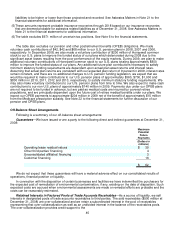 57
57 -
 58
58 -
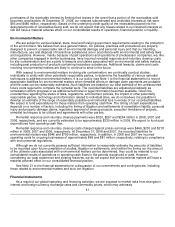 59
59 -
 60
60 -
 61
61 -
 62
62 -
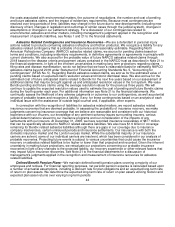 63
63 -
 64
64 -
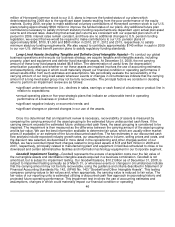 65
65 -
 66
66 -
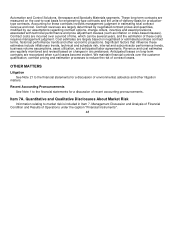 67
67 -
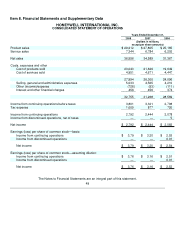 68
68 -
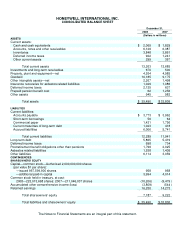 69
69 -
 70
70 -
 71
71 -
 72
72 -
 73
73 -
 74
74 -
 75
75 -
 76
76 -
 77
77 -
 78
78 -
 79
79 -
 80
80 -
 81
81 -
 82
82 -
 83
83 -
 84
84 -
 85
85 -
 86
86 -
 87
87 -
 88
88 -
 89
89 -
 90
90 -
 91
91 -
 92
92 -
 93
93 -
 94
94 -
 95
95 -
 96
96 -
 97
97 -
 98
98 -
 99
99 -
 100
100 -
 101
101 -
 102
102 -
 103
103 -
 104
104 -
 105
105 -
 106
106 -
 107
107 -
 108
108 -
 109
109 -
 110
110 -
 111
111 -
 112
112 -
 113
113 -
 114
114 -
 115
115 -
 116
116 -
 117
117 -
 118
118 -
 119
119 -
 120
120 -
 121
121 -
 122
122 -
 123
123 -
 124
124 -
 125
125 -
 126
126 -
 127
127 -
 128
128 -
 129
129 -
 130
130 -
 131
131 -
 132
132 -
 133
133 -
 134
134 -
 135
135 -
 136
136 -
 137
137 -
 138
138 -
 139
139 -
 140
140 -
 141
141 -
 142
142 -
 143
143 -
 144
144 -
 145
145 -
 146
146 -
 147
147 -
 148
148 -
 149
149 -
 150
150 -
 151
151 -
 152
152 -
 153
153 -
 154
154 -
 155
155 -
 156
156 -
 157
157 -
 158
158 -
 159
159 -
 160
160 -
 161
161 -
 162
162 -
 163
163 -
 164
164 -
 165
165 -
 166
166 -
 167
167 -
 168
168 -
 169
169 -
 170
170 -
 171
171 -
 172
172 -
 173
173 -
 174
174 -
 175
175 -
 176
176 -
 177
177 -
 178
178 -
 179
179 -
 180
180 -
 181
181 -
 182
182 -
 183
183 -
 184
184 -
 185
185 -
 186
186 -
 187
187 -
 188
188 -
 189
189 -
 190
190 -
 191
191 -
 192
192 -
 193
193 -
 194
194 -
 195
195 -
 196
196 -
 197
197 -
 198
198 -
 199
199 -
 200
200 -
 201
201 -
 202
202 -
 203
203 -
 204
204 -
 205
205 -
 206
206 -
 207
207 -
 208
208 -
 209
209 -
 210
210 -
 211
211 -
 212
212 -
 213
213 -
 214
214 -
 215
215 -
 216
216 -
 217
217 -
 218
218 -
 219
219 -
 220
220 -
 221
221 -
 222
222 -
 223
223 -
 224
224 -
 225
225 -
 226
226 -
 227
227 -
 228
228 -
 229
229 -
 230
230 -
 231
231 -
 232
232 -
 233
233 -
 234
234 -
 235
235 -
 236
236 -
 237
237 -
 238
238 -
 239
239 -
 240
240 -
 241
241 -
 242
242 -
 243
243 -
 244
244 -
 245
245 -
 246
246 -
 247
247 -
 248
248 -
 249
249 -
 250
250 -
 251
251 -
 252
252 -
 253
253 -
 254
254 -
 255
255 -
 256
256 -
 257
257 -
 258
258 -
 259
259 -
 260
260 -
 261
261 -
 262
262 -
 263
263 -
 264
264 -
 265
265 -
 266
266 -
 267
267 -
 268
268 -
 269
269 -
 270
270 -
 271
271 -
 272
272 -
 273
273 -
 274
274 -
 275
275 -
 276
276 -
 277
277 -
 278
278 -
 279
279 -
 280
280 -
 281
281 -
 282
282 -
 283
283 -
 284
284 -
 285
285 -
 286
286 -
 287
287 -
 288
288 -
 289
289 -
 290
290 -
 291
291 -
 292
292 -
 293
293 -
 294
294 -
 295
295 -
 296
296 -
 297
297 -
 298
298 -
 299
299 -
 300
300 -
 301
301 -
 302
302 -
 303
303 -
 304
304 -
 305
305 -
 306
306 -
 307
307 -
 308
308 -
 309
309 -
 310
310 -
 311
311 -
 312
312 -
 313
313 -
 314
314 -
 315
315 -
 316
316 -
 317
317 -
 318
318 -
 319
319 -
 320
320 -
 321
321 -
 322
322 -
 323
323 -
 324
324 -
 325
325 -
 326
326 -
 327
327 -
 328
328 -
 329
329 -
 330
330 -
 331
331 -
 332
332 -
 333
333 -
 334
334 -
 335
335 -
 336
336 -
 337
337 -
 338
338 -
 339
339 -
 340
340 -
 341
341 -
 342
342 -
 343
343 -
 344
344 -
 345
345 -
 346
346 -
 347
347 -
 348
348 -
 349
349 -
 350
350 -
 351
351 -
 352
352
 |
 |

combined with current market conditions and broad asset mix considerations (see Note 22 to the financial
statements for actual and targeted asset allocation percentages for our pension plans). The discount rate reflects
the market rate on December 31 (measurement date) for high-quality fixed-income investments with maturities
corresponding to our benefit obligations and is subject to change each year. Further information on all our major
actuarial assumption is included in Note 22 to the financial statements.
The key assumptions used in developing our 2008, 2007 and 2006 net periodic pension expense for our U.S.
plans included the following:
2008 2007 2006
Discount rate 6.50% 6.00% 5.75%
Assets:
Expected rate of return 9% 9% 9%
Actual rate of return (29%) 9% 14%
Actual 10 year average annual compounded rate of
return 4% 9% 10%
The discount rate can be volatile from year to year because it is determined based upon prevailing interest
rates as of the measurement date. We will use a 6.95 percent discount rate in 2009, reflecting the increase in the
market interest rate environment since December 31, 2007. We plan to continue to use an expected rate of
return on plan assets of 9 percent for 2009 based principally on our historical experience of actual plan returns.
The net losses for our pension plans were $6.0 billion at December 31, 2008 compared with $1.7 billion at
December 31, 2007. This increase of $4.3 billion is due primarily to asset losses in our U.S. plans in 2008 due to
the poor performance of the equity markets throughout 2008. The net losses at December 31, 2008 principally
result from actual plan asset returns below expected rates of return in 2008 and from the decline each year in the
discount rate for the period 2002 through 2006. Since our adoption of SFAS No. 158, "Employers' Accounting for
Defined Benefit Pension and Other Postretirement Plans (SFAS No. 158) as of December 31, 2006 which is
discussed in detail in Notes 1 and 22 to the financial statements such losses have been recognized as a
component of other comprehensive income (loss), net of tax. In the future we will continue to systematically
recognize such net losses in net periodic pension expense in accordance with Statement of Financial Accounting
Standards No. 87, "Employers Accounting for Pensions" (SFAS No. 87). Under SFAS No. 87, we use the market-
related value of plan assets reflecting changes in the fair value of plan assets over a three-year period. Further,
net losses in excess of 10 percent of the greater of the market-related value of plan assets or the plans' projected
benefit obligation (the corridor) are recognized over a six-year period.
Changes in net periodic pension expense may occur in the future due to changes in our expected rate of
return on plan assets and discount rate resulting from economic events. The following table highlights the
sensitivity of our U.S. pension obligations and expense to changes in these assumptions, assuming all other
assumptions remain constant:
Change in Assumption Impact on Annual
Pension Expense Impact on PBO
0.25 percentage point decrease in discount rate Increase $50 million Increase $303 million
0.25 percentage point increase in discount rate Decrease $50 million Decrease $295 million
0.25 percentage point decrease in expected rate of
return on assets Increase $29 million —
0.25 percentage point increase in expected rate of
return on assets Decrease $29 million —
Net periodic pension expense for our pension plans is expected to be approximately $170 million in 2009, a
$193 million increase from 2008 due principally to an increase in the amortization of net losses in our U.S. plans.
The increase in the amortization of net losses results principally from asset losses due to the poor performance
of the equity markets throughout 2008.
In 2008, 2007 and 2006 we were not required to make contributions to satisfy minimum statutory funding
requirements in our U.S. pension plans. However, we made voluntary cash contributions of $42, $42 and $68
million to our U.S. pension plans in 2008, 2007 and 2006, respectively, for government contracting purposes. In
December 2008, we also made a voluntary contribution of $200
45
